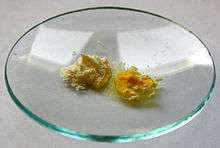Xanthoproteic reaction

The xanthoproteic reaction is a method that can be used to determine the amount of protein soluble in a solution, using concentrated nitric acid. The test gives a positive result in those proteins with amino acids carrying aromatic groups, especially in the presence of tyrosine. If the test is positive the proof is neutralized with an alkali, turning dark yellow. The yellow colour is due to xanthoproteic acid which is formed due to nitration of certain amino acids, most common examples being tyrosine and tryptophan.[1] This chemical reaction is a qualitative test, determining the presence or absence of proteins.
Procedure
Add 1 ml of concentrated HNO3 to 1 ml of the test sample. Heat the mixture and cool it. Slowly add sodium hydroxide (40% w/v in water) solution until the mixture becomes alkaline and a colour change is noted. If the colour changes from yellow to orange, this indicates the presence of an aromatic amino acid.
Real Life
When you drop nitric acid on your skin or nails, it turns yellow after some time, indicating the presence of protein. The finger nails show a bright yellow colour (finger nails are made up of keratin- a protein) which cannot be scraped off, unlike the yellow colouration on the skin which can be peeled off.
References
- ↑ Chatterjea (1 January 2004). Textbook of Biochemistry for Dental/Nursing/Pharmacy Students. Jaypee Brothers Publishers. p. 51. ISBN 978-81-8061-204-6.